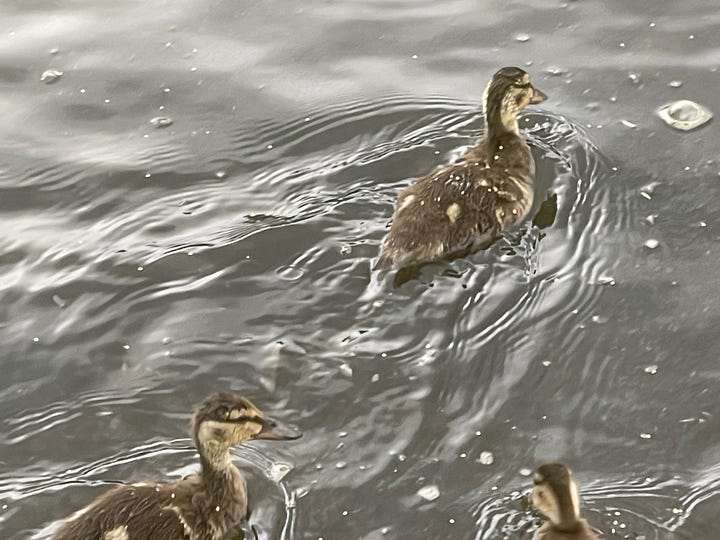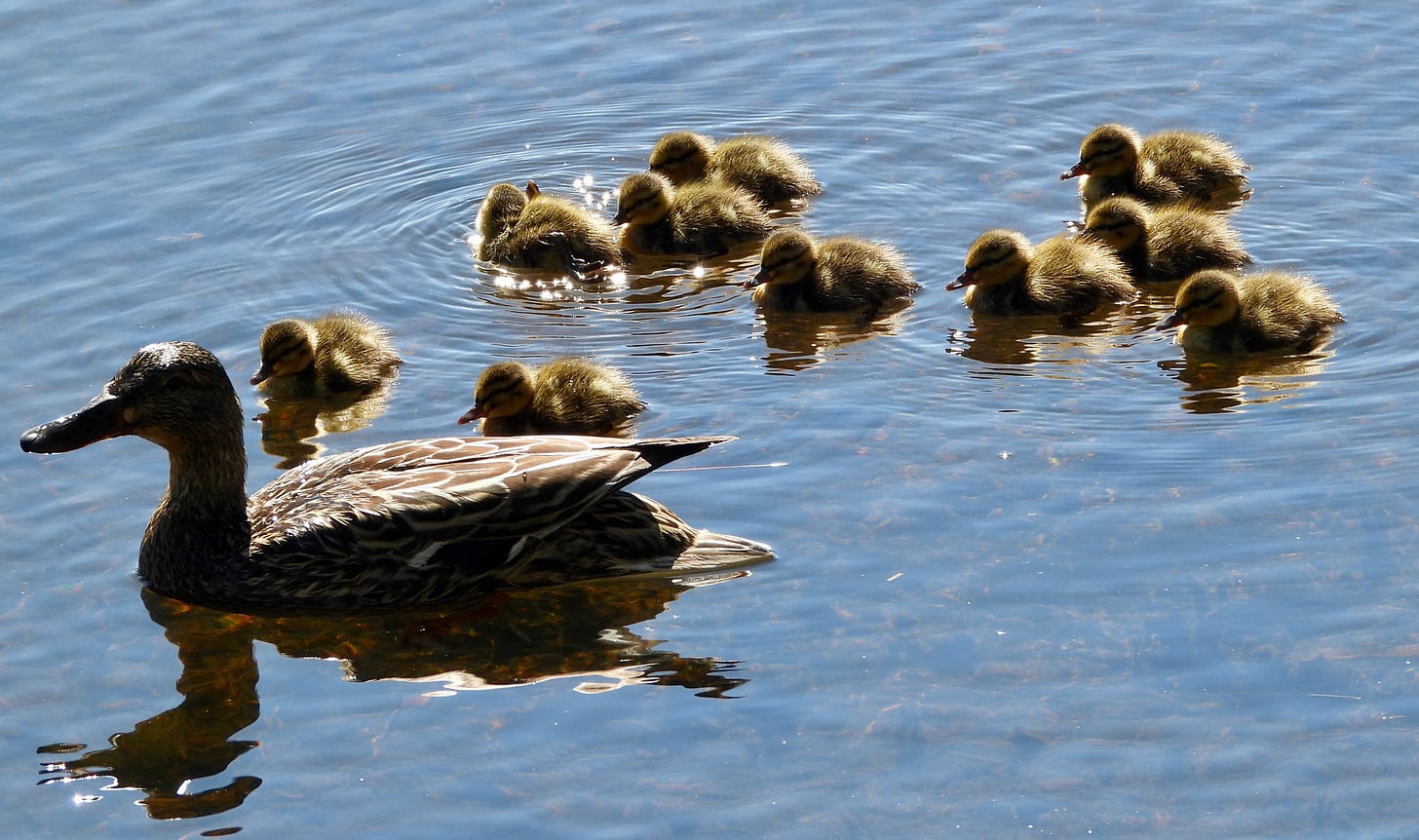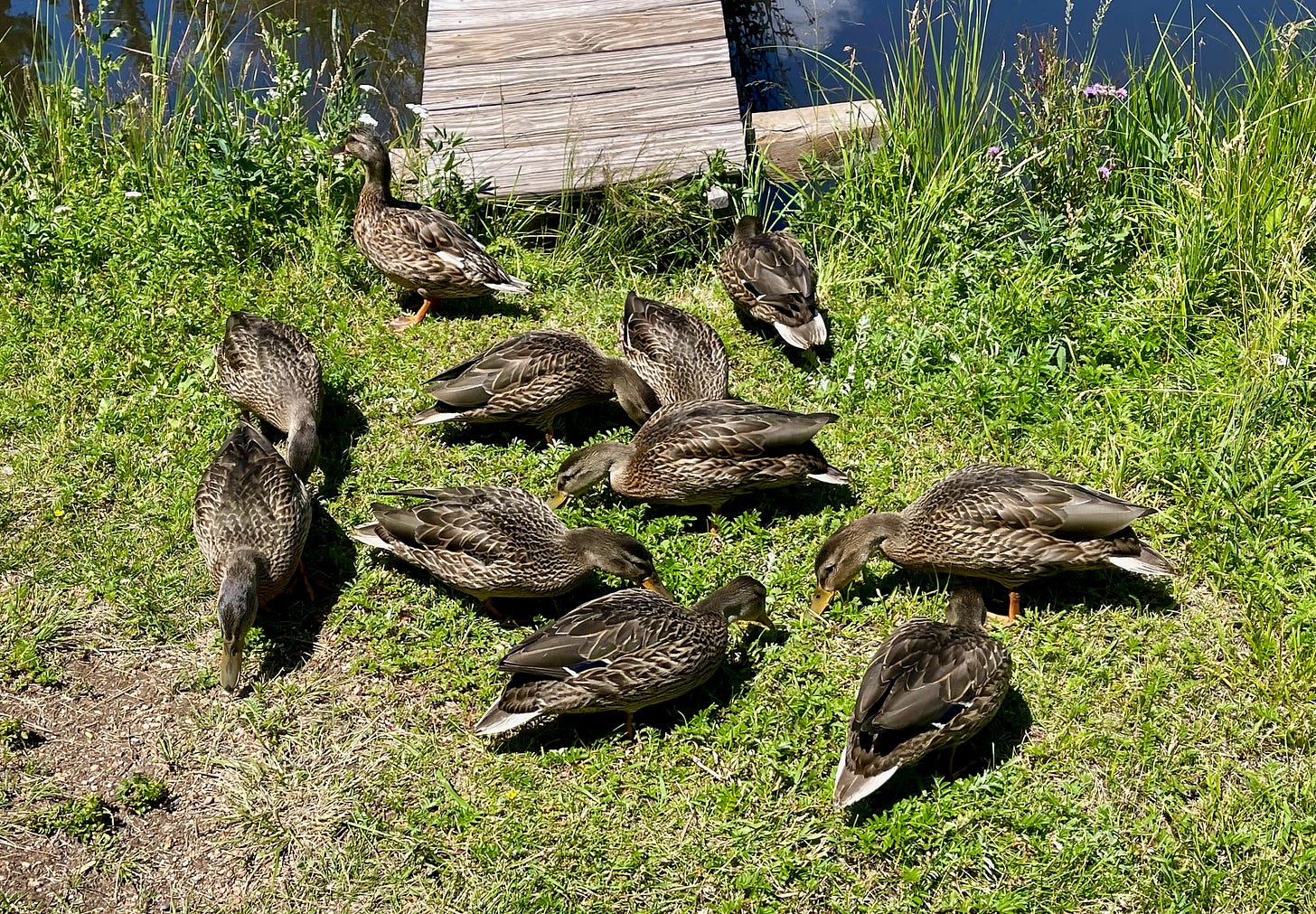I made French toast for Sunday breakfast. From my seat at the table I could see the pond, there were ripples from a duck gliding by, and I didn’t think much of it, but then the duck was followed by a train of fuzzy ducklings. I abandoned my breakfast and ran for my camera and down to the pond.
Ten - I counted them over and over. Ten! It had been a couple years since we’ve had a successful brood of ducklings. Only about 3-4 inches long, some are slightly bigger, some smaller, depending on who had hatched first.
Most infant birds are scrawny, near bald, noisy, demanding, helpless, overall, rather ugly creatures - this is called, altricial. Ducklings, though, are precocial, creatures that are capable of movement and feeding themselves soon after birth.
Their downy coats dry to an adorable fuzz, and they will be able to swim relatively soon (a few days to a week after hatching) once their feather down develops the oils needed to protect them. Swimming is instinctive, but very young ducklings can get exhausted and drown. Our little pond is a good size for learning to swim. Mama had them on an outing for 20 minutes or so before she tucked them up on the grassy bank hidden in the sedges for a nap. Their faint peeps could only be heard by getting near the water’s edge, a quiet, but chaotic, popcorn-popping sort-of cadence.
I sat still, snapping away with the silent setting with my camera. I did not want to alarm Mama, and she tolerated my presence — because she knew me. It is a reasonable guess that this is Ethel, of our pair-bonded Henry and Ethel, that return to our pond, spring after spring, to set up house. Henry dutifully watches over Ethel while she dabbles for seed bits under the bird feeder. He fends off other males from Ethel’s area and ensures her safety as much as he can. Last year, she made her nest on our little island, but it was raided by raccoons one night and was gone. She seems to be more determined, and wiser, this year in her nesting location and protection. Not wanting to disturb their napping location, I returned to my breakfast.

Mallards, to many, perhaps, are the classic image of all the ducks. They are the most numerous, over 19 million on a recent count, most widespread over the Northern Hemisphere, most hunted, most eaten, and frequent predatory targets by raptors, foxes, and coyotes. The males’ distinctive greenish-purple head feathers and their ‘drake feather’ curling up from their tails make this duck the most recognizable in the world. So, here, in our little pond, is a Mama who had lost a brood previously, is very evidently proud and protective of each of her ten. And I, as a Mama also who has lost a child, and then have my children, felt fiercely protective of this particular ten as well.
Oh, but we know well the fate of many ducklings and nestlings here in the mountains. We have seen previous broods diminish seemingly day by day. We knew we’d likely catch the sight of a fox trotting off with a duckling in its mouth, and that is nature. A duckling to feed fox kits or Red Tail nestlings creates a broad balance on the earth. The Great Blue Heron that lives in the area took notice of them and spent more time at our pond. Mama kept them under her wings when the Heron was around, that is, until they were too big for a heron to snatch.
Each day, we’d see them out on the pond, and each day, there were 10. Counted each time we saw them, counted by neighbors, and even visitors. Yep, 10 still!
Well, there was Dopey. Often, we’d go down to visit the ducklings and the count would be off, there’s one missing — uh, oh. We learned to scan the sedges around the opposite side of the pond, and there would be Dopey, the littlest one, off exploring, independent and brash.
Mama ducks have a special voice for their ducklings, and the babies know it well. They have cues when they can explore and when to pull in close to Mama. They know when to huddle together under her wings for extra protection, they know when to stay together even if Mama is not right there. This communication is only between them and Mama. This communication has kept them alive and safe.
Under Mama's protective wings Watch the video to the end to see how many ducklings Mama can fit under her wings.
One pond visit, all the ducklings were under Mama’s wings and there was another pair of adult Mallards lazily floating in the pond. This might seem to be innocent, but other adult Mallards, especially those who have lost their own brood, have been known to kill the broods of other families. Mama would take no chances. What amazed us as we approached, was that when Mama saw us walking up, she moved off the ducklings and into the pond. The ducklings huddled tightly together on Mama’s orders, and she charged into the pond to drive off the intruders. “I think we were just put on baby-sitting duty,” my daughter quipped. Sure enough, we watched as Mama was soon pushing chest to chest with the male, quacking loudly and nipping his feathers. The intruder ducks flew off with Mama in hot, and noisy, pursuit. The ducklings stayed together, and we stayed nearby until Mama flew back with a splash landing in the pond. At that signal, the ducklings all moved to the pond to be with her, and life returned to normal.
We watched them change rapidly. In just a few weeks, they had more than doubled in size, their early feathers darkening, their coloring and their spots more pronounced. As they grew, feathers came in, but not all at once. For a time, they were half down and half feathers, awkward teenagers that they were. By mid-July, we had a hard time telling Mama from the babies. The only telling sign was the size of their wings, still so tiny compared to the adults.


We watched them learn to be a duck. One day, it was catching bugs, racing around to catch them in the air. Another day, it was being able to dunk fully underwater to grab a snack. This was so fun, they practiced over and over. “Mama, look at me!”
And finally, their wings grew. We found them racing around the pond. Siblings racing each other at their top speeds, aided by wings getting larger and stronger. They would waddle up to our little bridge and do awkward practice jumps testing their wings, getting a little further each time. All this was flight practice.
At times, they weren’t at our pond at all. Ours isn't the only pond these ducks have made a home in, with several other ponds up and down the stream also serving as frequent feeding spots. Word was spreading of a possible altercation had taken place in one of these ponds, between the brood of ten and possibly some dogs. The grim outcome that these rumors suggested was that Mama Duck, and possibly one of the babies, had been taken, but their fates truly unknown. For a bitter, angry week, this was all we had to go off of. We felt that the rest of the ducklings hadn’t grown big enough to survive on their own, and could not fly yet, to be able to evade other predators without Mama. Then, one day, the group was at the pond, they waddled up on shore to greet me, and I began the count… 8—9—10—11! They were all there, Mama and all 10 ducklings! Whatever had transpired at the other pond, this entire brood had survived it, every one of them, just as they'd survived everything before. We should have trusted the protective instinct of Mama more, I’m sure she saw danger and had them hide. The ducklings were so big now we could barely tell them apart from Mama. The main telltale sign was Mama’s vigilance watching for danger, head held high and ‘on a swivel’ ever watchful. Profoundly relieved, we were so glad they were back.
Their return didn’t last long though, in a few days we saw a number of them on the little bridge and soon ALL of them took to the sky, most with the stumbling grace of 15 yr old first learning to drive, but in the air, they were. Their wings now gave them the freedom to explore further, get stronger, and prepare for the upcoming migration. They also can become independent of Mama and each other at this point. Their flight, meant to us, that they are OK to go. Like a child off to college, we wished them the best and watched them take to their independence.
Late summer to Fall is the season when the intense drama of mating is done. (Ho boy, is that a subject for a future post!) For ducks, it is a time to rest and many will group together. Our small pond has seen 30-60 ducks peacefully coexisting while they molt the old feathers and grow the new. (See link for previous post on the Molt.) It is also a vulnerable time as new flight feathers take time to grow in and flight is limited. There is strength and protection in numbers, so they help each other. By the time the snow arrives, these ducks will be off to find open water south of here.
As ducks often return to their nesting grounds to raise their own broods, we may likely see some of this gang again in the springs to come. It was certainly a surprising joy to have them around this summer. They aren’t ‘just Mallards’ to us.
Sources:
- https://en.wikipedia.org/wiki/Mallard
- https://www.ducks.org/conservation/waterfowl-research-science/mallard-life-cycle
Thank you for stopping by. While my normal life is full with my paying job, other volunteer work, and family time, I write these posts out of my own naturalist curiosity, and love of writing and photography. Many times, this blog has to take a back seat to my other obligations, but I always have the next post on my mind. My subject matter is limitless! If you have enjoyed these posts, I would, shyly, ask for your support of my work here. Please consider subscribing or upgrading to a paid subscription, and do share what you have enjoyed. I am looking at some benies for paid subscribers of artwork from Itsthemoonart©️, whose artwork has appeared in other posts and my logo (my naturalist-artist daughter and content advisor) and other ideas. I am very thankful for all my subscribers and supporters! Oh! And please let me know if you have ideas you’d like to see a post about!
📷 All photos are credit: The Abert Essays unless otherwise noted.
📱 Join me on my Facebook page and other social media. I post smaller ‘Encounters’ posts there as I see flowers, animals, weather patterns, and anything else that catches my eye.











What a great essay, thanks. It's so easy to take Mallards for granted but they're worth paying attention to. Your Mama Mallard was very lucky to get all 10 ducklings to such an advanced age. On our local canal, we regularly see large Mallard families reduced in number as the gulls and herons eat the youngsters.
Wonderful, wonderful! I loved this essay as much as any I've read on ducks! My own parental instincts kicked in for the safety of the fuzzy little brood! Restacking to Notes!